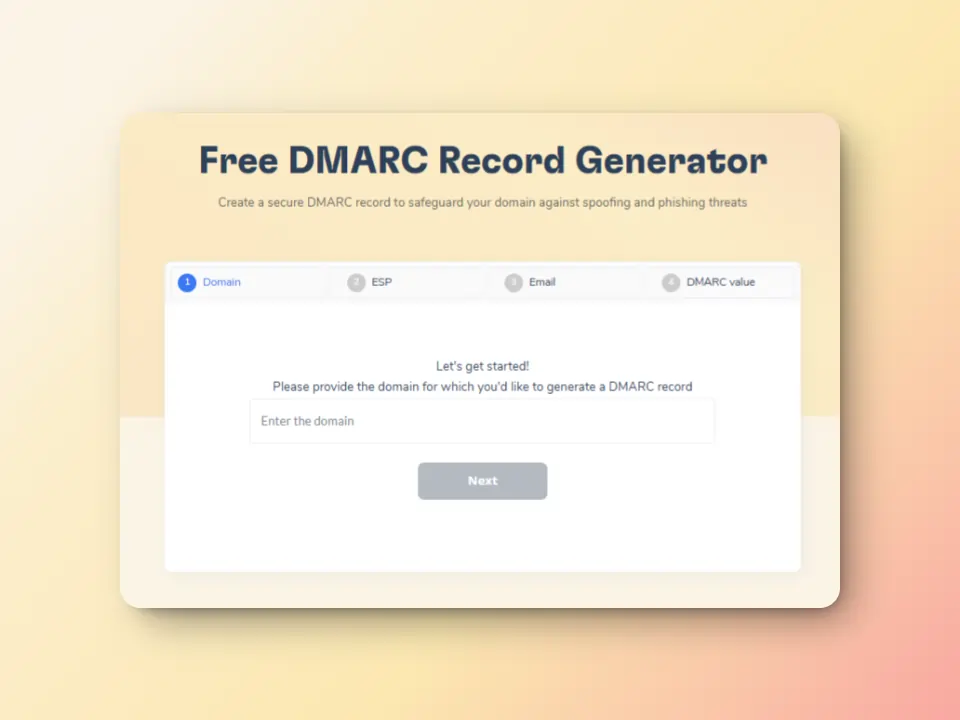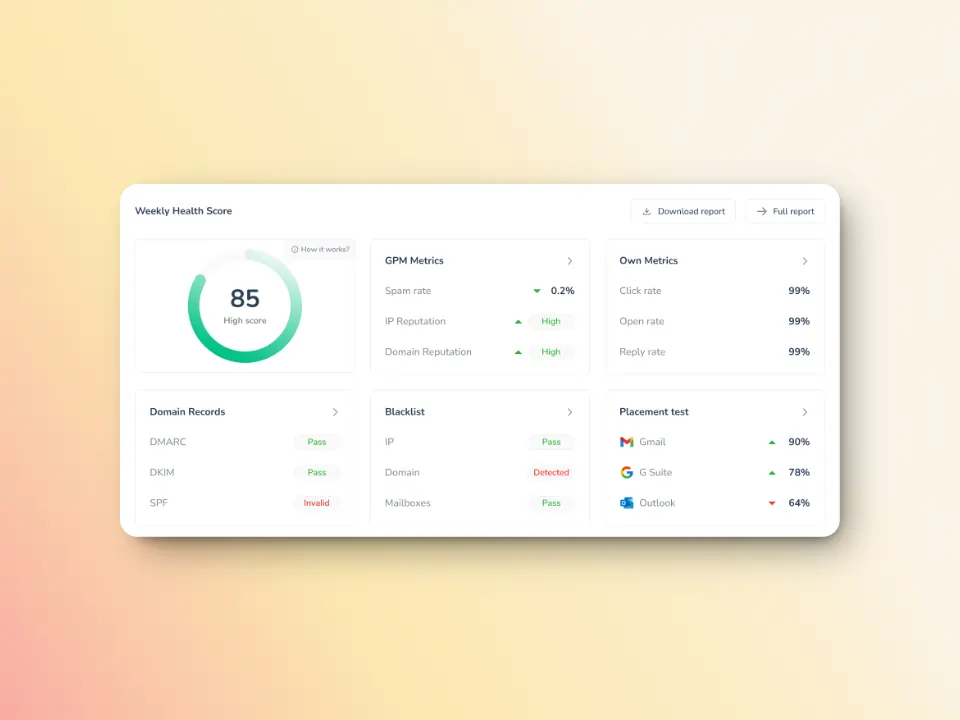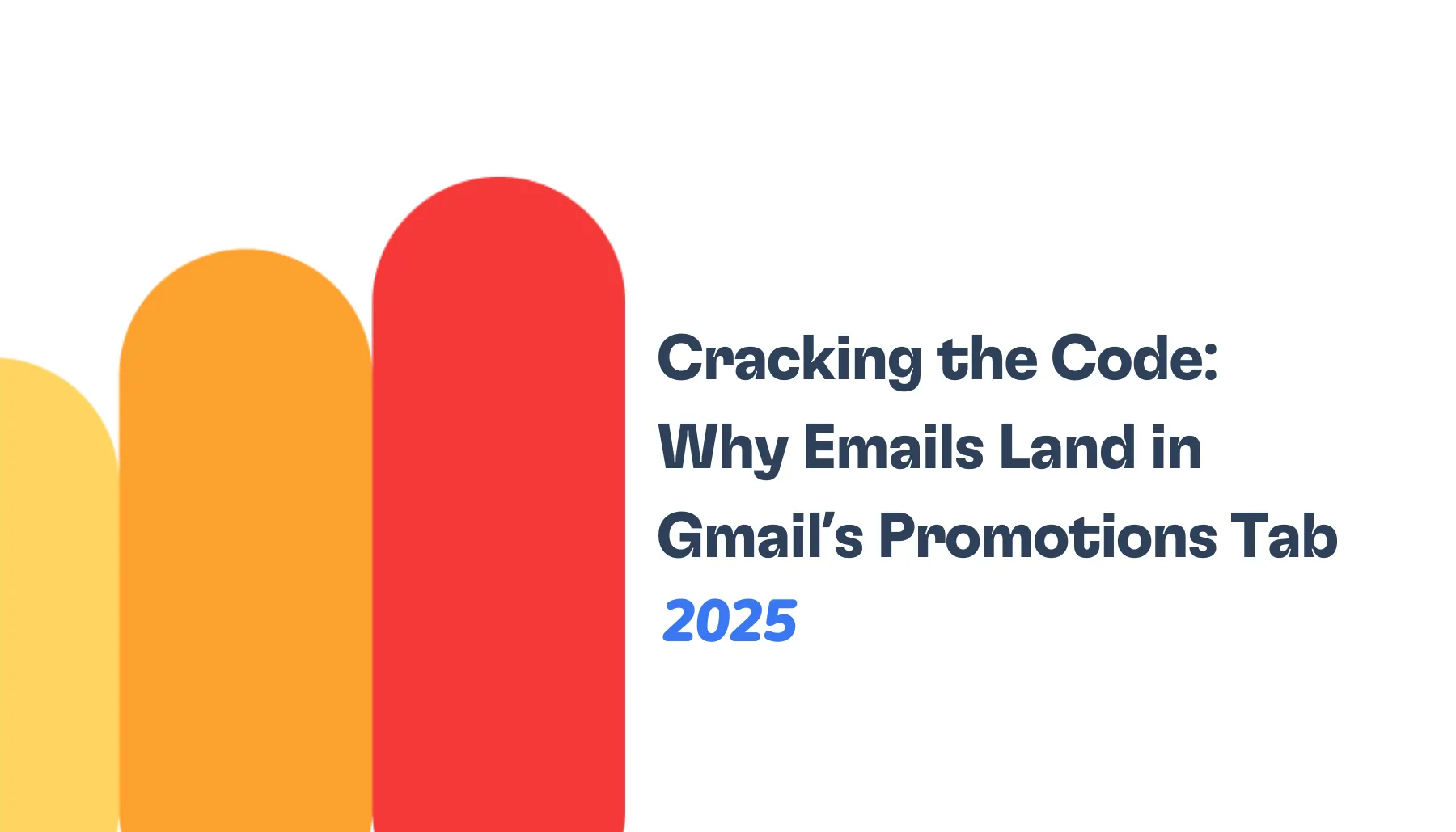When emails vanish, the outrage is understandable. You’ve spent hours putting together the perfect email. The subject is attention-getting, the design is beautiful and your offer…? Spot on. You hit send, you wait … and then comes the letdown. Open rates are down. Responses are nowhere to be found. Some contacts even say they found your message languishing in their spam folder. Sound familiar?
If you’re nodding along, you’re not alone.
Email deliverability problems are all too common—and incredibly annoying. No matter if you’re launching a new sales campaign, or a nurture sequence, or an update to your product, it’s all for naught if your emails never make it into the inboxes of your audience. You’ll miss out on the $36 for every $1 spent ROI.
The good news? You can take control of this. And no, you don’t need to be an email tech wizard to solve the problem.
Let’s dive in and get your emails back where they belong: front and center in the inbox.
What is email deliverability and why does it matter more than you think?
Let’s clear something up first: The fact that an email is sent does not mean it ends up in the inbox.
Email deliverability is ability of your emails to arrive at the inbox of recipients. Not the spam folder, not the promotions tab, and certainly not the black hole.
There’s a huge difference between email delivery and email deliverability:
- Delivery means the email has been accepted by the recipient’s server.
- Deliverability means the email actually landed in the inbox.
So, yes, your email can be “delivered” and yet be entirely invisible to your audience if it’s flagged as spam or junk.
Now here’s why this matters:
Better deliverability rate means that more of your emails are being seen. You know what happens when your email gets seen? It gets opened. Opened emails lead to clicks. Clicks turn into conversions. And conversions? That’s revenue.
So even the best-written emails won’t get a chance to perform if your email deliverability isn’t up to snuff. What does this mean? Before you optimize your subject lines, thank you pages or CTAs, you first have to make sure your emails are even making it to the door.
Why emails go to spam (or don’t show up at all)
When your email doesn’t reach the inbox, it’s not always about what you wrote. Sometimes it’s about how your domain behaves, or how your email list is built. Let’s go through the most common reasons your emails could be missing out on experiencing the inbox.
1. Poor domain reputation
Think of your domain like a credit score for email. The better your track record, the more likely inbox providers (like Gmail or Outlook) will trust you.
Q: What is domain reputation?
A: It is a score that email providers assign to your domain based on how trustworthy your emails are. It’s influenced by factors like spam complaints, bounce rates, and engagement—and it directly affects whether your emails land in the inbox or spam folder.
🔖 Related Reading: The Ultimate Guide to Understanding and Improving Domain Reputation
Your domain reputation is shaped by:
- How often people open, click, or delete your emails (email engagement metrics)
- Whether recipients report your emails as spam
- If you’ve ever landed on an email blacklist (a list of domains flagged for bad behavior)
Low engagement or too many spam complaints can tank your reputation fast—and once your domain is on a blacklist, your deliverability takes a major hit.
2. Missing or misconfigured authentication
Internet Service Providers (ISPs) want to know that you are indeed who you say you are. With around 3.4 billion phishing emails sent daily, it’s only right that email service providers do whatever it takes to protect their users.
Here’s where SPF, DKIM, and DMARC come in:
- SPF (Sender Policy Framework) verifies your IP is allowed to send on behalf of your domain.
- DKIM (DomainKeys Identified Mail) adds a digital signature to prove the email is legit.
- DMARC (Domain-based Message Authentication, Reporting, and Conformance) tells email servers what to do if SPF or DKIM checks fail.
Q: How do they impact deliverability?
A: SPF, DKIM, and DMARC are email authentication protocols that verify your emails are coming from a trusted source. When these records are properly set up, they help prevent spoofing and improve your sender reputation—making it more likely your emails reach the inbox instead of spam.
If you’re missing even one of these records, or if they’re set up incorrectly, your emails might be marked as suspicious or spoofed. And suspicious emails go straight to spam.
🔖 Related Reading: Mastering Email Deliverability: The Modern Guide to Authentication and Inbox Warm-Up is a report from the Warmy Research Team that looks into where email warm-up and authentication intersect. The report also provides a deeper look into SPF, DKIM, and DMARC.
3. Content that triggers spam filters
No matter how useful, informative or downright awesome your message is, spam filters can’t interpret your intentions. They judge your content. There’s a reason why these words have been associated with spam, after all. These filters are designed to shield inboxes from sketchy emails and, well, sometimes even a legit email can trip the wires if it looks suspicious.
Here’s what commonly sets off alarms:
- “Spammy” trigger words: Phrases like “Buy now!”, “Act fast!”, “Limited offer”, and “Congratulations!” are classic spam bait. Use them too much and your email might get flagged and your spam score will go up.
- Overly formatted emails: Think ALL CAPS, a trail of exclamation points (!!!), bolded or highlighted words everywhere. These appear aggressive and suspicious to spam filters.
- Suspicious links: URLs that are shortened, broken, or don’t match your domain can appear untrustworthy.
- Unbalanced image-to-text ratio: If your email campaign is basically one big image or has too many visuals with barely any text, filters may assume you’re hiding something (like phishing links).
- Unnecessary or risky attachments: Especially file types like .zip, .exe, or even PDFs from unknown sources. If it’s not absolutely necessary, skip the attachment and link to a landing page instead.
Bottom line: keep your content clean, readable, and natural for great email performance. If it looks spammy to you, it’ll look spammy to a filter too and it might be marked as spam.
4. Dirty or outdated email lists
Your email list is only as valuable as it is healthy. Sending email marketing campaigns to old, disengaged, or irrelevant contacts does more harm than good . Plus, doing so can seriously damage your sender reputation.
Here is an example of what a “dirty” list could include:
- Outdated contacts: If someone hasn’t opened your email in months (or years), odds are they won’t start anytime soon.
- Invalid or misspelled email addresses: These cause hard bounces, which tell ISPs that you’re not keeping your list clean and up-to-date.
- Spam traps: These are fake or dummy email addresses set up by ISPs to catch shady senders. If you’re hitting these, it means you’re either scraping emails or not properly verifying your list. (Read more: What is a Spam Trap & How to Avoid It)
These are dummy email addresses created by ISPs to catch bad senders. If this is what you’re hitting, you are either scraping email or you’re not verifying your list correctly.
And just to be clear: buying email lists is never a good idea. It might seem like an easy way to build followers, but it is more likely to put you on a blacklist or have your account suspended. Always build your list the right way through opt-ins, lead magnets, and genuine interest.
5. Sending practices that backfire
Sending emails isn’t just about what you send—it’s also how and when you send it. Internet Service Providers (ISPs) are always on the lookout for spam-like activity, and erratic sending habits are a big warning sign.
Here’s what can trigger them:
- Sudden spikes in volume: If you’ve been quiet for quite and suddenly send out thousands of emails, it looks suspicious.
- Inconsistent sending schedule: Going from daily to monthly to weekly confuses ISPs and can hurt your sender reputation.
- High volume from a new domain or IP: If you start sending large volumes from a brand-new domain or IP address without warming it up, you’re basically waving a red flag in front of a spam filter.
To stay on the safe side, warm up your domain gradually, follow a consistent schedule, and avoid massive, unannounced sends. A little patience goes a long way in building trust with inbox providers.
🔖 Related Reading: The Science and Process of Warming Up Newly Created Email Domains is another goldmine from the Warmy Research Team. This report contains details of a comprehensive series of tests involving different email platforms and diverse domain configurations.
How to test email deliverability (fast!)
So, you suspect your emails are landing in spam—or worse, not showing up at all. Before diving into fixes, the smartest move is to test your email deliverability. That way, you’re not just guessing what’s wrong. You’re getting actual data. Here’s how you can quickly run a free deliverability test with Warmy.io and get real answers in just a few clicks.
Step 1: Go to Warmy.io’s free deliverability test tool
No signup hoops, no tech setup. Just head over to Warmy.io’s Free Email Deliverability Test and click “Start Test.” You’ll be instructed to copy and paste a set of email addresses.
Step 2: Send an email to the provided address
Open your email platform (whether it’s Gmail, Outlook, or your favorite email marketing tool), and send a real email to the addresses Warmy provided. It could be a campaign you plan to send—or even a test message with links, images, and formatting. This step mimics what a typical recipient would receive, and that’s exactly what the tool analyzes.
Step 3: Let Warmy do its magic
Within 3-5 minutes, Warmy checks your email deliverability and shows you the following data:
- The percentage of emails that landed in the inbox, the promotions tab, or straight into spam across different providers like Gmail, Outlook, Yahoo.
- Percentage of emails that weren’t received at all
- Warmy checks if your domain or IP is listed on major blacklists.
Step 4: Get clear, actionable results inside the Warmy dashboard
Warmy users get more data from deliverability tests compared to the free tool on the site. And no, you don’t need to pay anything—Warmy offers a free trial for seven days. You can try running the test again from within the platform and get additional insights:
- Deliverability score
- Status of DNS Records
- Scores for spam rate, domain reputation, and IP reputation
And here’s the best part: No technical expertise needed. It’s literally built for marketers, founders, and business owners who just want fast answers without decoding a bunch of jargon.
Improving deliverability beyond testing with Warmy.io
Now that you’ve run your email through Warmy.io’s free deliverability test, you probably have a clear picture of where things stand. It’s time to take action on the results. Whether your email landed in spam or passed with flying colors, the steps below will help you fine-tune your setup and stay in the inbox long-term.
1. Check your authentication setup
Email authentication is like your digital passport. It proves you’re legit. If your SPF, DKIM, or DMARC records are missing or misconfigured, email providers might treat your messages as suspicious and block or spam them.
You can also cross-check your DNS records using tools like:
- MXToolbox SPF Checker
- Google Admin Toolbox CheckMX
If something’s off, your domain provider or IT team can help you update the records. You can also use the following free tools from Warmy’s stack:
- Free SPF Record Generator: helps create a valid SPF record to prevent unauthorized email sending.
Free DMARC Record Generator: strengthens email security by preventing phishing and spoofing attacks.

2. Run your content through Warmy’s Template Checker (free)
Even with perfect authentication, your email content could still raise red flags. When you test your email with Warmy.io’s free template checker, it checks your content for spam triggers that will set off spam filters and lets you know exactly what can trigger alarms. This makes it super easy to tweak your email and re-test until you get a clean bill of health before executing campaigns.

Bonus: The template checker now has a Chrome Extension, making it even easier to edit your emails as you draft them and avoid spam filters.
3. Monitor comprehensive data via the Domain Health Hub

Warmy’s Domain Health Hub provides a domain-level health dashboard with the following features:
- A domain health score based on factors like authentication, blacklist status, and inbox placement tests. You’ll also be able to monitor your spam rate trends and overall deliverability performance with weekly or monthly tracking options.
- Comprehensive DNS status checks to easily validate SPF, DKIM, DMARC, rDNS, MX, and A records for stronger authentication & security.
Monitoring of blacklists and presence on them - Quick access to a detailed breakdown
4. Implement AI-powered warmup with customizable settings
Warmy.io is essentially a deliverability solution designed specifically to help senders improve their email deliverability rates. Its email warmup feature gradually builds trust with ISPs by mimicking natural email interactions to show ISPs that your emails are trusted and valuable.

How Warmy.io’s email warmup works:
- Automatically yet gradually increases sending volume to build trust with mailbox providers.
- Simulates real human-like interactions—emails are opened, replied to, and marked as important to boost deliverability.
- Works across 30+ languages to reach global audiences
5. Maximize deliverability with advanced seed lists
Unlike traditional warm-up tools that rely on fake or bot-generated email interactions, Warmy.io uses advanced seed lists containing genuine email addresses—trusted mailboxes that engage with your emails like real recipients would. This further strengthens sender reputation across multiple email providers.

Warmy has also recently introduced the API Endpoint for Established Seed List, a new way to access, manage, and configure your seed list splits directly from your system. What does this mean?
- No more manual updates, and no more time wasted
- Seamless integration with real-time seed list data that goes straight into your system with API access.
- Efficiency boost via automated split management which reduces errors, and saves valuable time.
- Better inbox placement due to properly configured splits mean fewer bounces and stronger sender reputation.
Don’t leave your deliverability to chance—take charge today!
Email deliverability might seem like a behind-the-scenes issue, but it’s a major player in how well your campaigns perform. The good news? It’s fixable and with Warmy, it’s definitely faster than you think.
With the right tools and a few smart tweaks, you can boost your inbox placement, protect your sender reputation, and get your emails in front of the people who actually want to see them.
Discover exactly what’s blocking your emails from landing in the inbox, and fix it fast. Try Warmy.io’s free deliverability test tool today. No tech skills needed, you just need 3-5 minutes of your time.











